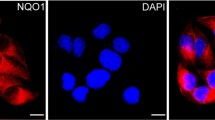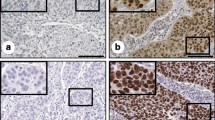Abstract
Purpose
Oct3/4 a transcription factor is involved in maintaining the characteristics of cancer stem cells. Oct3/4 can be expressed differentially with respect to the progression of cervical cancer (CC). In addition, Oct3/4 can give rise to three isoforms by alternative splicing of the mRNA Oct3/4A, Oct3/4B and Oct3/4B1. The aim of this study was to evaluate the mRNA expression from Oct3/4A, Oct3/4B and Oct3/4B1 in low-grade squamous intraepithelial lesion (LSIL), high-grade squamous intraepithelial lesion (HSIL), CC samples, and measure the effect of the HPV16 E7 oncoprotein on the mRNA expression from Oct3/4 isoforms in the C-33A cell line.
Methods
The expression levels of Oct3/4A, Oct3/4B and Oct3/4B1 mRNA were analyzed by reverse transcription quantitative polymerase chain reaction (RT-qPCR) in patients with LSILs, HSILs and CC. Additionally, C-33A cells that expressed the HPV16 E7 oncoprotein were established to evaluate the effect of E7 on the expression of Oct3/4 mRNA isoforms.
Results
Oct3/4A (p = 0.02), Oct3/4B (p = 0. 001) and Oct3/4B1 (p < 0. 0001) expression is significantly higher in patients with LSIL, HSIL and CC than in woman with non-IL. In the C-33A cell line, the expression of Oct3/4A mRNA in the presence of the E7 oncoprotein increased compared to that in nontransfected C-33A cells.
Conclusion
Oct3/4B and Oct3/4B1 mRNA were expressed at similar levels among the different groups. These data indicate that only the mRNA of Oct3/4A is upregulated by the HPV16 E7 oncoprotein.





Similar content being viewed by others
Data Availability
The data used to support the findings of this study are available from the corresponding author upon request.
References
GLOBOCAN GLOBOCAN (IARC) (2020) Available online at: https://gco.iarc.fr/ [accessed June 1, 2020]
American Cancer Society (2020) Available online at: https://www.cancer.org/ [accessed November 1, 2020]
World Health Organization (2014) Comprehensive cervical cancer control: a guide to essential practice, [Accessed Oct, 2020]; Available at: https://www.ncbi.nlm.nih.gov/books/NBK269619/. 2nd edition ed
Lin J, Albers AE, Qin J, Kaufmann AM (2014) Prognostic significance of overexpressed p16INK4a in patients with cervical cancer: a meta-analysis. PLoS ONE 9(9):e106384. https://doi.org/10.1371/journal.pone.0106384
Wise-Draper TM, Wells SI (2008) Papillomavirus E6 and E7 proteins and their cellular targets. Front Biosci 13:1003–1017. https://doi.org/10.2741/2739
Roman A, Munger K (2013) The papillomavirus E7 proteins. Virology 445(1–2):138–168. https://doi.org/10.1016/j.virol.2013.04.013
Alberti L, Losi L, Leyvraz S, Benhattar J (2015) Different Effects of BORIS/CTCFL on Stemness Gene Expression, Sphere Formation and Cell Survival in Epithelial Cancer Stem Cells. PLoS ONE 10(7):e0132977. https://doi.org/10.1371/journal.pone.0132977
Li S-W, Wu X-L, Dong C-L, Xie X-Y, Wu J-F, Zhang X (2015) The Differential Expression of OCT4 Isoforms in Cervical Carcinoma. PLoS ONE 10(3):e0118033. https://doi.org/10.1371/journal.pone.0118033
Wang YD, Cai N, Wu XL, Cao HZ, Xie LL, Zheng PS (2013) OCT4 promotes tumorigenesis and inhibits apoptosis of cervical cancer cells by miR-125b/BAK1 pathway. Cell Death Dis 4(8):e760. https://doi.org/10.1038/cddis.2013.272
Takahashi K, Tanabe K, Ohnuki M, Narita M, Ichisaka T, Tomoda K et al (2007) Induction of pluripotent stem cells from adult human fibroblasts by defined factors. Cell 131(5):861–872. https://doi.org/10.1016/j.cell.2007.11.019
Wang X, Dai J (2010) Concise review: isoforms of OCT4 contribute to the confusing diversity in stem cell biology. Stem Cells 28(5):885–893. https://doi.org/10.1002/stem.419
Villodre ES, Kipper FC, Pereira MB, Lenz G (2016) Roles of OCT4 in tumorigenesis, cancer therapy resistance and prognosis. Cancer Treat Rev 51(1):1–9. https://doi.org/10.1016/j.ctrv.2016.10.003
Liu D, Zhou P, Zhang L, Wu G, Zheng Y, He F (2011) Differential expression of Oct4 in HPV-positive and HPV-negative cervical cancer cells is not regulated by DNA methyltransferase 3A. Tumour Biol 32(5):941–950. https://doi.org/10.1007/s13277-011-0196-z
Organista-Nava J, Gómez-Gómez Y, Ocadiz-Delgado R, García-Villa E, Bonilla-Delgado J, Lagunas-Martínez A et al (2016) The HPV16 E7 oncoprotein increases the expression of Oct3/4 and stemness-related genes and augments cell self-renewal. Virology 499(1):230–242. https://doi.org/10.1016/j.virol.2016.09.020
Gao J, Aksoy BA, Dogrusoz U, Dresdner G, Gross B, Sumer SO et al (2013) Integrative analysis of complex cancer genomics and clinical profiles using the cBioPortal. Sci Signal 6(269):pl1. https://doi.org/10.1126/scisignal.2004088
Cerami E, Gao J, Dogrusoz U, Gross BE, Sumer SO, Aksoy BA et al (2012) The cBio cancer genomics portal: an open platform for exploring multidimensional cancer genomics data. Cancer Discov 2(5):401–404. https://doi.org/10.1158/2159-8290.cd-12-0095
Tang Z, Li C, Kang B, Gao G, Li C, Zhang Z (2017) GEPIA: a web server for cancer and normal gene expression profiling and interactive analyses. Nucleic Acids Res 45(W1):W98–w102. https://doi.org/10.1093/nar/gkx247
Zhai Y, Kuick R, Nan B, Ota I, Weiss SJ, Trimble CL et al (2007) Gene expression analysis of preinvasive and invasive cervical squamous cell carcinomas identifies HOXC10 as a key mediator of invasion. Cancer Res 67(21):10163–10172. https://doi.org/10.1158/0008-5472.can-07-2056
Barrett T, Wilhite SE, Ledoux P, Evangelista C, Kim IF, Tomashevsky M et al (2013) NCBI GEO: archive for functional genomics data sets–update. Nucleic Acids Res 41(1):D991–D995. https://doi.org/10.1093/nar/gks1193
Alarcón-Romero LDC, Organista-Nava J, Gómez-Gómez Y, Ortiz-Ortiz J, Hernández-Sotelo D, Del Moral-Hernández O et al (2022) Prevalence and Distribution of Human Papillomavirus Genotypes (1997–2019) and Their Association With Cervical Cancer and Precursor Lesions in Women From Southern Mexico. Cancer Control 29:1–21. https://doi.org/10.1177/10732748221103331
Leornard D, Michael K, James B. Basic methods in molecular biology1994
Nolan T, Hands RE, Bustin SA (2006) Quantification of mRNA using real-time RT-PCR. Nat Protoc 1(3):1559–1582. https://doi.org/10.1038/nprot.2006.236
Asadi MH, Mowla SJ, Fathi F, Aleyasin A, Asadzadeh J, Atlasi Y (2011) OCT4B1, a novel spliced variant of OCT4, is highly expressed in gastric cancer and acts as an antiapoptotic factor. Int J Cancer 128(11):2645–2652. https://doi.org/10.1002/ijc.25643
Aguilar-Lemarroy A, Gariglio P, Whitaker NJ, Eichhorst ST, zur Hausen H, Krammer PH et al (2002) Restoration of p53 expression sensitizes human papillomavirus type 16 immortalized human keratinocytes to CD95-mediated apoptosis. Oncogene 21(2):165–175. https://doi.org/10.1038/sj.onc.1204979
Xu S, Sui S, Zhang J, Bai N, Shi Q, Zhang G et al (2015) Downregulation of long noncoding RNA MALAT1 induces epithelial-to-mesenchymal transition via the PI3K-AKT pathway in breast cancer. Int J Clin Exp Pathol 8(5):4881–4891
Cortés-Malagón EM, Bonilla-Delgado J, Díaz-Chávez J, Hidalgo-Miranda A, Romero-Cordoba S, Uren A et al (2013) Gene expression profile regulated by the HPV16 E7 oncoprotein and estradiol in cervical tissue. Virology 447(1–2):155–165. https://doi.org/10.1016/j.virol.2013.08.036
Kim BW, Cho H, Choi CH, Ylaya K, Chung JY, Kim JH et al (2015) Clinical significance of OCT4 and SOX2 protein expression in cervical cancer. BMC Cancer 15(1):1015. https://doi.org/10.1186/s12885-015-2015-1
Chiou SH, Wang ML, Chou YT, Chen CJ, Hong CF, Hsieh WJ et al (2010) Coexpression of Oct4 and Nanog enhances malignancy in lung adenocarcinoma by inducing cancer stem cell-like properties and epithelial-mesenchymal transdifferentiation. Cancer Res 70(24):10433–10444. https://doi.org/10.1158/0008-5472.can-10-2638
Hu T, Liu S, Breiter DR, Wang F, Tang Y, Sun S (2008) Octamer 4 small interfering RNA results in cancer stem cell-like cell apoptosis. Cancer Res 68(16):6533–6540. https://doi.org/10.1158/0008-5472.can-07-6642
Panayiotou T, Michael S, Zaravinos A, Demirag E, Achilleos C, Strati K (2020) Human papillomavirus E7 binds Oct4 and regulates its activity in HPV-associated cervical cancers. PLoS Pathog 16(4):e1008468. https://doi.org/10.1371/journal.ppat.1008468
Brehm A, Ohbo K, Zwerschke W, Botquin V, Jansen-Dürr P, Schöler HR (1999) Synergism with germ line transcription factor Oct-4: viral oncoproteins share the ability to mimic a stem cell-specific activity. Mol Cell Biol 19(4):2635–2643. https://doi.org/10.1128/mcb.19.4.2635
da Silva PBG, Teixeira Dos Santos MC, Rodini CO, Kaid C, Pereira MCL, Furukawa G et al (2017) High OCT4A levels drive tumorigenicity and metastatic potential of medulloblastoma cells. Oncotarget 8(12):19192–19204. https://doi.org/10.18632/oncotarget.15163
Gariglio P, Organista-Nava J, Alvarez-Rios E (2016) Role of HR-HPVs E6 and E7 oncoproteins in cervical carcinogenesis. J Mol Genet Med 10(216):1747-0862.1000216. https://doi.org/10.4172/1747-0862.1000216
Kareta MS, Gorges LL, Hafeez S, Benayoun BA, Marro S, Zmoos AF et al (2015) Inhibition of pluripotency networks by the Rb tumor suppressor restricts reprogramming and tumorigenesis. Cell Stem Cell 16(1):39–50. https://doi.org/10.1016/j.stem.2014.10.019
Lin T, Chao C, Saito S, Mazur SJ, Murphy ME, Appella E et al (2005) p53 induces differentiation of mouse embryonic stem cells by suppressing Nanog expression. Nat Cell Biol 7(2):165–171. https://doi.org/10.1038/ncb1211
Chambers I, Colby D, Robertson M, Nichols J, Lee S, Tweedie S et al (2003) Functional expression cloning of Nanog, a pluripotency sustaining factor in embryonic stem cells. Cell 113(5):643–655. https://doi.org/10.1016/s0092-8674(03)00392-1
Chew JL, Loh YH, Zhang W, Chen X, Tam WL, Yeap LS et al (2005) Reciprocal transcriptional regulation of Pou5f1 and Sox2 via the Oct4/Sox2 complex in embryonic stem cells. Mol Cell Biol 25(14):6031–6046. https://doi.org/10.1128/mcb.25.14.6031-6046.2005
Acknowledgements
We thank all of the Instituto Estatal de Cancerología ‘‘Dr. Arturo Beltrán Ortega’’ and Secretaría de Salud personnel who helped with this study at the clinic sites. We also thank technicians of Laboratorio de Biomedicina Molecular for their excellent laboratory assistance.
Funding
The present study was supported by grant from CONACYT, México (Investigación Científica Básica 2016; grant no. 288612).
Author information
Authors and Affiliations
Contributions
Gómez-Gómez Y: Data collection, Validation, Formal analysis, and Manuscript original draft preparation. Organista-Nava J: Conceptualization, Data collection, Validation, Formal analysis, Project administration, Manuscript writing—review and editing. Clemente-Periván SI: Data collection, Formal analysis, and Manuscript original draft preparation. Lagunas-Martínez A: Data collection. Salmerón-Bárcenas EG: Data collection, and Formal analysis. Villanueva-Morales D: Data collection. Ayala-Reyna DY: Data collection. Alarcón-Romero L del C: Data collection. Ortiz-Ortiz J: Data collection. Bello-Rios C: Data collection. Jiménez-López MA: Data collection. Leyva-Vázquez MA: Data collection. Illades-Aguiar B: Conceptualization, Project administration and Funding acquisition. All authors have read and agreed to the published version of the manuscript.
Corresponding authors
Ethics declarations
Conflict of interest
The authors declare that they have no conflict of interest.
Ethical approval
This study was approved by the Bioethical Committee of the Universidad Autónoma de Guerrero and Instituto Estatal de Cancerología ‘‘Dr. Arturo Beltrán Ortega’’ (approval no. FO-INV-AUT2018).
Consent to participate
This study was conducted in accordance with the guidelines of the Declaration of Helsinki. Written informed consent was obtained from all participants prior your registration in this study. Data confidentiality was maintained throughout the study.
Consent for publication
All authors consent to the publication of this manuscript.
Additional information
Publisher’s Note
Springer Nature remains neutral with regard to jurisdictional claims in published maps and institutional affiliations.
Electronic supplementary material
Below is the link to the electronic supplementary material.
Rights and permissions
Springer Nature or its licensor (e.g. a society or other partner) holds exclusive rights to this article under a publishing agreement with the author(s) or other rightsholder(s); author self-archiving of the accepted manuscript version of this article is solely governed by the terms of such publishing agreement and applicable law.
About this article
Cite this article
Gómez-Gómez, Y., Organista-Nava, J., Clemente-Periván, S.I. et al. The expression of Oct3/4A mRNA and not its isoforms is upregulated by the HPV16 E7 oncoprotein. Mol Biol Rep 50, 981–991 (2023). https://doi.org/10.1007/s11033-022-07988-9
Received:
Accepted:
Published:
Issue Date:
DOI: https://doi.org/10.1007/s11033-022-07988-9




